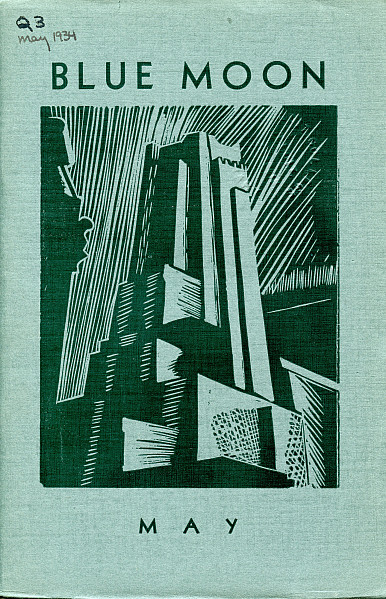Fridays with Fred: Blue Moon, the trail-blazing, student-founded literary journal

Beloit College students have a remarkably long tradition of activism and entrepreneurship. Whenever students want to try something new or different, Beloit often provides the opportunity, regardless of official sanction. Student funds and backbreaking labor built our first gymnasium in the 19th century. Back then, students also formed literary societies, banjo clubs, social fraternities, and a “base ball” team, sometimes without the approval of college faculty and administration. In the 20th and 21st centuries, student organizations frequently appeared with a splash and then disappeared when the founders graduated. Some groups, such as BSFFA—the Beloit Science Fiction and Fantasy Association—proved long-lived, while others, such as the Cannabis Club of the mid-’90s, flamed out in a proverbial puff of smoke after only a year or two.

Students have always craved outlets for their creative work. The Beloit College Monthly, and later, the Round Table, provided ample space for budding journalists and essayists and occasionally printed special “literary” issues, but the newsprint format seemed too ephemeral for serious literary writing. In early October 1929, just a few weeks before the Wall Street stock market crashed on “Black Tuesday,” Beloit College senior Kenneth B. Arrington hatched out a plan. As Round Table editor he found it easy to broadcast his idea on the newspaper’s front page:
A literary quarterly is probable for the future in Beloit. Most colleges of the size of ours have publications which present typical work of both students and faculty…The need of just some such magazine has been felt in Beloit for quite some time…It is believed that the field for a literary journal in Beloit is vast and its prospects are bright…
Rather than going an entirely independent route, editor-in-chief Arrington and his nascent editorial staff sought official approval by way of the college’s Committee on Activities. The committee liked the plan and the staff of the as yet unnamed publication conferred in dorm room “bull sessions,” huddled outside on crisp autumn afternoons, and whispered much too loudly in the study rooms of the Carnegie Library. By the end of October they had a budget, a deadline for submissions, and at long last, a name: Blue Moon.
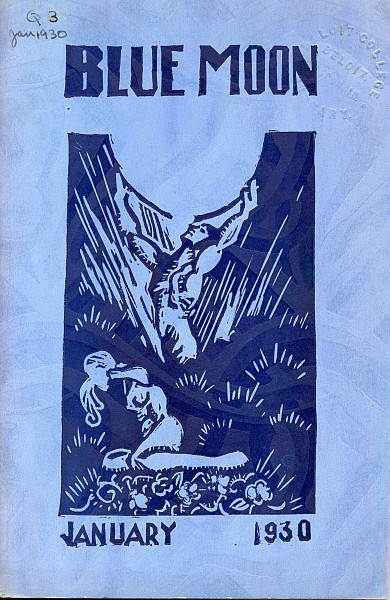
Plans called for a 48 page staple-bound magazine with quality paper and an attractive cover. The staff organized a subscription drive, offering three issues for one dollar, while charging 35 cents per single copy. Editors also sent out a call for submissions:
Anything of a literary nature, from very free verse to deeply philosophical essays will be acceptable…In addition to containing essays, stories and poetry [the magazine] will be illustrated with wood-cuts and pictures.
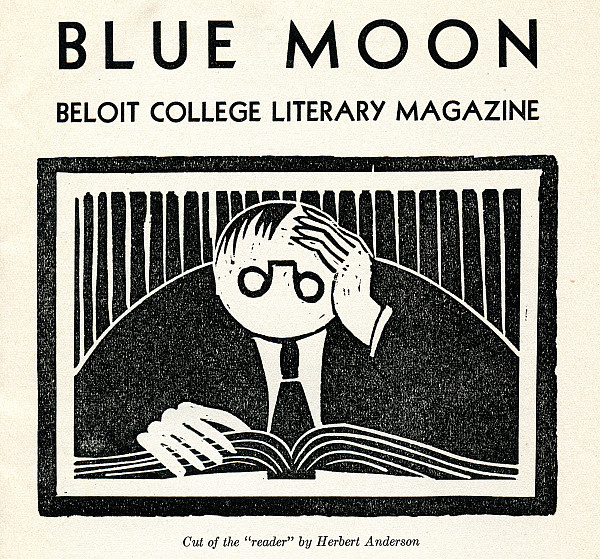
Over the next several weeks, the Blue Moon staff continued to ask for submissions. Possibly in order not to discourage contributors, by early November, their request for “very free verse” had evolved into “extremely free verse.” They also specified interest in linoleum block prints and line drawings. In time, such distinctive artwork became one of the magazine’s outstanding features.
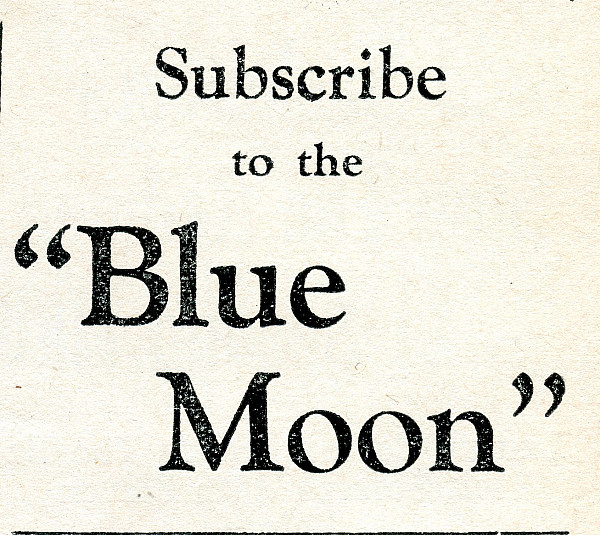
Meanwhile, Managing Editor Arthur Henry Glanz and his staff sought paid advertisements from community businesses, many of which were happy to oblige. Blue Moon’s first issue featured, among others, Wisconsin Power and Light (“To Electrify is to Satisfy”), Murkland’s Shoe Store (“Shoes Correctly Fitted with X-Ray”), and the Hotel Hilton, announcing its new coffee shop. In a special “Chapel Campaign,” Blue Moon staff managed to snag 200 student subscribers, and the resultant promotion attracted even more subscriptions.

By early December, Blue Moon seemed about ready to go to press as planned. Unfortunately, on Dec.18, the Round Table announced that readers would have to wait until after Christmas vacation: “However, practically all the material for this issue is now prepared…The magazine will be very attractive and contain interesting contributions by Professor Clancy [and] Professor Crawford.” The same issue noted that the 25-year-old literary magazine published by the University of Wisconsin had gone defunct due to lack of support by students and faculty. “We fail to ‘view with alarm,’” the columnist wrote, “for we feel that Beloit will make it succeed.”
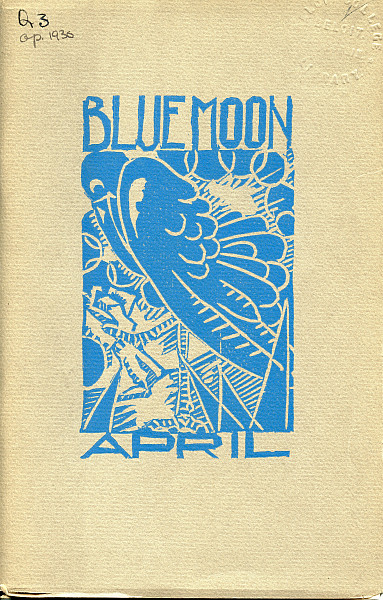
In the tradition of most literary magazines, there were further delays before publication. Then, one frigid January day in 1930, providing some needed literary warmth, Blue Moon appeared in all its glory, prose and poetry set in venerable Caslon type between a richly hued, appropriately blue cover.
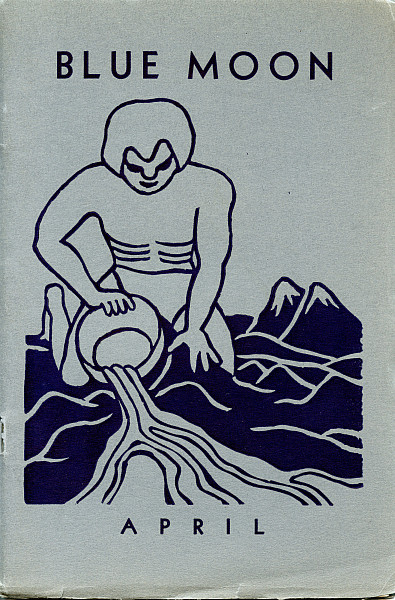
Blue Moon continued as a venue for campus literature and artwork until 1934, when it ceased publication. Perhaps the ever-deepening financial woes of the Great Depression did it in. Over the next 80 years, student writers and artists founded other distinguished literary magazines, including Satyre, Avatar, and Pocket Lint, but Blue Moon, with its stunning Art Deco covers, was the trailblazer.
Of no concern my momentary clay,
Flaming with fevers, fall in a day
To baleful broken coal of pain and sorrow –
The flesh of yesterday, today, tomorrow.
The coddled bone and sinew, these shall pass
Down to dead embers, as any blazing mass.
Small consequence the body of the pyre,
The crackling boughs, the smoldering ash, the fire
But paramount the wistful flame, serene,
Nurtured by embers; the spirit, tremulous, clean,
And sinewy blue like the shadow of a soul
Eerily dancing on the dying coal.
As any blazing birchwood falls apart,
Groaning, consumed, and flings up from its heart
An essence that goes winding to a cloud
In a ghostly flame within a smoking shroud –
So may I go, when my burning boughs crash
And nothing remains but feebly glowing ash,
And wisp of spirit spiraling and bending
Starward in tenuous flame and smoke ascending.
“Flame and Smoke” by Lew Sarett, class of 1911, published in the second issue of Blue Moon, April, 1930.
